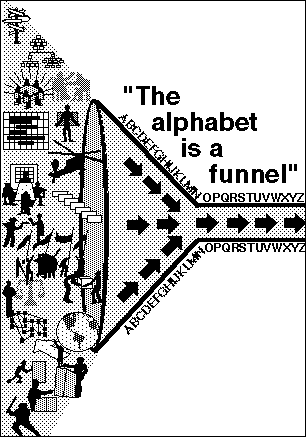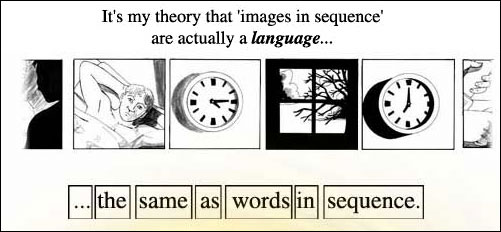October 04, 2003
More thoughts on Urban Tribes
A post to the Many to Many weblog about how Friendster relies on Urban Tribes got me thinking. I tried posting this as a comment there, but there was an error. So I'm posting it here:
======
As the author of the scathing review, I feel it's worth mentioning that I agree with danah that Friendster's bread-and-butter are those who belong to "urban tribes." Actually, the Friendster/Urban Tribes cross is a potentially rich field for exploration of this emerging social group. I'm thinking of a sociological/anthropological discussion of how social software mediates and extends the interactions of these folks. Is it coincidence that Urban Tribes emerged as a force at around the same time as the internet took off? How has email, IM, and now systems like Friendster promoted the development of Urban Tribes?
October 02, 2003
Understood Loud and Clear
Last night I went to see LOST IN TRANSLATION. It's nearly as good as everyone says. It's a thoughtfully-paced character study that, remarkably, never bores. It helps to have Bill Murray -- film cameras love Bill Murray, and Bill Murray loves film cameras. And while he's been earning deserved accolades, his performance isn't really all that surprising -- he's done just as well in films like GROUNDHOG DAY or RUSHMORE.
Scarlet Johannson, on the other hand, shines brightly in a way we've not seen her before. Folks will be familiar with her good work in GHOST WORLD and THE MAN WHO WASN'T THERE. But she was always a supporting character. In this film, she does work worthy of a Best Actress nod. (Not that she'll get it. The Academy doesn't take young actors seriously for such honors.) Charlotte (Scarlet's character) is the emotional heart of the film. If Scarlet's performance doesn't pan out, the film simply wouldn't work, and no amount of Bill Murray's mugging could save it. But Scarlet maintains her intensity, her hold on you (and on Bob), letting you believe everything you see on the screen.
For those who've seen the movie, I'm including more commentary in the extended entry of this post....
One thing that no critic has mentioned is that Bill Murray's character is essentially impotent. He might be a rich and famous movie star, but his life is driven by others, all women -- his wife choosing carpet colors, Charlotte buying him a drink and inviting him to hang out with friends, the call girl demanding he "lip my stocking," the women who lead him around as he does his work duties, the singer who picks him up at the bar.
Charlotte is dynamic, and the heart of the film, because she does her own thing. While Bob is being poked, prodded, tucked, and directed, Charlotte's learning ikebana, or visiting temples. Charlotte has the nerve to buy him a drink, the idea to drag him out to hang out with friends.
[SPOILER]
It makes the end of the movie all the more poignant. It's not just Bob getting out of a taxi to say one last goodbye. It's Bob, for the first time in the entire film, acting on his own impulses, exerting his own free will, breaking free of the leash he'd been letting himself be lead by.
Other though:
Critics have been giving Giovanni Ribisi's character an unfair rap. He is most definitely *not* the problem in their relationship. He's dopey, sure, and work-obsessed. But he clearly loves Charlotte. Charlotte's malaise has far less to do with him than with herself.
September 29, 2003
Are You The Crapkeeper? I am the Fluidmaster!
So, the toilet acted up last night. Wouldn't stop filling. The gizmo the shuts off the flow just wasn't working.

Luckily, the fill valve is a Fluidmaster from Kohler. And Fluidmaster's web site is chock-filled with helpful material for the fill valve owner. Troubleshooting tips, installation instructions, random toilet trivia, all illustrated.
It's why we love the Web.
September 28, 2003
Reading PIctures
So, in preparing for my keynote on modelling human behavior observed in research, I've taken a detour into the world of Visual Languages.
It began by looking up Tufte's Visual Explanations, and then trying to find texts related to it. Click through books under the subject "visual communication," I came across Visual Language, a book by Robert E. Horn. I've come across his stuff before, but never pursued it deeply. Now seemed the time.

The book is intriguing. Robert essentially lays out a deconstruction of visual language, beginning with the elements "words," "shapes", and "images," and then showing the various way these things can be cobbled together to communicate in a fashion richer than afforded with just one of the elements. The book is valuable for its breadth and depth alone -- a veritable catalog of ways that people have used visual language to communicate over the years. The book's single greatest disappointment is its ugliness -- the imagery too stark, the typography clumsy, the point often lost in hard-to-read graphics. This speaks to the fact that Horn seems to be most focused on a business audience -- the land of PowerPoint -- and so not as concerned with subtlety.
This business focus was disappointing... My cursory research leads me to suspect that the social sciences and humanities are *terrible* when it comes to utilizing visual language (with the occasional exception of statistics representations). I hope Horn's message is breaking beyond middle management and helping convince academia that the primacy of The Word above all else is shortsighted and foolish.
So today I've been wandering the Web, looking for more. I haven't found anything useful to my talk, but I've uncovered some keen items.

Emaki Productions is the web home of Neil Cohn, a decidedly precocious pup (he seems to have gotten his undergrad degree in 2002), who has written a fair amount about communicating visually. He seems to favor narrative and comics... Reading his site immedately calls Understanding Comics to mind.
![]()
The Visual Language Collection offers facet freaks a change to see an clever interface to a faceted classification collection. Unfortunately, the site isn't yet live.
Oh, and of course, there's Tufte's site. I don't need to mention that, do I?
And, um, that's it. I had trouble finding good stuff. Maybe you've got some pointers? It's interesting how poorly represented this field of visual language is, considering its prevalence and increasing importance. But I guess it's not "owned" by any one discipline, it's utilized across disciplines, and so there's no focused need for research and analysis.
